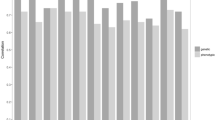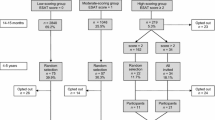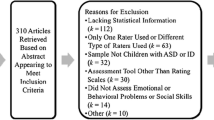Abstract
Most research on child behavior incorporates information from different individuals. While agreement between informants is generally only modest, there is little understanding of the processes underlying disagreement. In twin studies, differential agreement among raters for MZ and DZ twins is of particular concern. The processes underlying differences among mother, father, and child ratings of oppositional and conduct disorder symptoms are explored. Evidence in favor of a shared parental view of behavior is presented. Parental ratings give higher intrapair correlations, which could be due to either parents rating their twins more similarly or twins contrasting themselves. Rater bias and situational specificity are among the possible explanations of differential ratings. The effects of incorporating multiple raters of behavior on estimates of genetic and environmental effects are explored. These suggest that genetic influences are greater for the shared (multiple-rater) phenotype than for individual ratings; reduction in measurement error is only a partial explanation.
Similar content being viewed by others
References
Achenbach, T. M., and Edelbrock, C. S. (1981). Behavior problems and competencies reported by parents of normal and disturbed children age four through sixteen.Monogr. Soc. Res. Child Dev. 46:No. 188.
Achenbach, T. M., McConaughy, S. H., and Howell, C. T. (1987). Child/adolescent behavioral and emotional problems: Implications of cross-informant correlations for situational specificity.Psychol. Bull. 101:213–232.
American Psychiatric Association (1987)The Diagnostic and Statistical Manual of Mental Disorders (Third Edition, Revised), American Psychiatric Association, Washington, DC.
Angold, A., and Costello, E. J. (1995). A test-retest reliability study of child-reported psychiatric symptoms and diagnosis using the Child and Adolescent Psychiatric Assessment (CAPA).Psychol. Med. (in press).
Angold, A., Weissman, M. M., John, K., Merikangas, K. R., Prusoff, B. A., Wickramaratne, P., Gammon, G. D., and Warner, V. (1987). Parent and child reports of depressive symptoms in children at low and high risk of depression.J. Child Psychol. Psychiat. 28:901–915.
Angold, A., Prendergast, M., Cox, A., Harrington, R., Simonoff, E., and Rutter, M. (1995). The Child and Adolescent Psychiatric Assessment (CAPA) Interview.Psychol. Med. (in press).
Bentler, P. M. (1989).EQS: Structural Equations Program Manual, BMDP Statistical Software, Los Angeles.
Campbell, D. T., and Fiske, D. W. (1959). Convergent and discriminant validation by the multitrait multimethod matrix.Psychol. Bull. 105:317–327.
Eaves, L. J., Silberg, J. L., Hewitt, J. K., Rutter, M., Meyer, J. M., Neale, M. C., and Pickles, A. (1993). Analyzing twin resemblance in multisymptom data: Genetic applications of a latent class models in symptoms of conduct disorder in juvenile boys.Behav. Genet. 22:5–19.
Edelbrock, C., Costello, A. M., Dulcan, M. K., Conover, N. C., and Kala, R. (1986). Parent-child agreement on child psychiatric symptoms assessed via structured interview.J. Child Psychol. Psychiat. 27:181–190.
Fergusson, D. M., and Horwood, L. J. (1987a). The trait and method components of ratings of conduct disorder. I. Maternal and teacher evaluations of conduct disorder in young children.J. Child Psychol. Psychiat. 28:249–260.
Fergusson, D. M., and Horwood, L. J. (1987b). The trait and method components of ratings of conduct disorder. II. Factors related to the trait component of conduct disorder scores.J. Child Psychol. Psychiat. 28:261–271.
Herjanic, B., and Reich, W. (1982). Development of a structured psychiatric interview for children: Agreement between child and parent on individual symptoms.J. Abnorm. Child Psychol. 10:307–324.
Herjanic, B., Herjanic, M., Brown, F., and Wheatt, T. (1975). Are children reliable reporters?J. Abnorm. Child Psychol. 3:41–48.
Hewitt, J. K., Silberg, J. L., Neale, M. C., Eaves, L. J., and Erickson, M. (1992). The analysis of parental ratings of children's behavior using LISREL.Behav. Genet. 22: 293–318.
Hewitt, J. K., Eaves, L. J., Silberg, J. L., Rutter, M. E. S., Meyer, J. M., Loeber, R., Neale, M. C. Erickson, M., Kendler, K. S., Heath, A. C., Pickles, A., Truett, K. R., and Maes, H. (1995). Genetics and developmental psychopathology: The Virginia Twin Study of Adolescent Behavioral Development (submitted for publication).
Kashini, J. H., Orvaschel, H., Burk, J. P., and Reid, J. C. (1985). Informant variance: The issue of parent-child disagreement.J. Am. Acad. Child Psychiat. 24:437–441.
Kazdin, A. E., Esveldt-Dawson, K., Unis, A. S., and Rancurello, M. D. (1983). Child and parent evaluations of depression and aggression in psychiatric inpatient children.J. Abnorm. Child Psychol. 11:401–413.
Kendler, K. S., Heath, A. C., Martin, N. G. and Eaves, L. J. (1987). Symptoms of anxiety and symptoms of depression. Same genes, different environments?Arch. Gen. Psychiat. 44:451–457.
Lahey, B. B., and Loeber, R. (1994). Framework for a developmental model of oppositional defiant disorder and conduct disorder. In Routh, D. K. (ed.),Disruptive Behavior Disorders in Childhood, Plenum, New York, pp. 139–180.
Loeber, R., Green, S. M., Lahey, B. B., and Stouthamer-Loeber, M. (1989). Optimal informants on childhood disruptive behaviors.Dev. Psychopathol. 1:317–337.
Loeber, R., Green, S. M., Lahey, B. B., and Stouthamer-Loeber, M. (1991). Differences and similarities between children, mothers, and teachers as informants on disruptive child behavior.J. Abnorm. Child Psychol. 19:75–95.
Maes, H., Meyer, J., Silberg, J., Hewitt, J., Simonoff, E., Pickles, A., Rutter, M., and Eaves, L. J. (1995). Zygosity determination in the Virginia Twin Study of Adolescent Behavioral Development (in preparation).
McGuffin, P., and Gottesman, I. I. (1985). Genetic influences on normal and abnormal development. In Rutter, M., and Hersov, L. A. (eds.),Child and Adolescent Psychiatry: Modern Approaches, Blackwell Scientific, Oxford, pp. 17–33.
Neale, M. C., and Cardon, L. R. (1992).Methodology for Genetic Studies of Twins and Families, Kluwer Academic, Dordrecht.
Neale, M. C., and Stevenson, J. (1989). Rater bias in the EASI temperament scales: A twin study.J. Personal. Soc. Psychol. 56:446–455.
Olweus, D. (1980). Familial and temperamental determinants of aggressive behavior in adolescent boys: A causal analysis.Dev. Psychol. 16:644–660.
Orvaschel, H., Puig-Antich, J., Chambers, W., Tabrizi, M. A., and Johnson, R. (1982). Retrospective assessment of prepubertal major depression with Kiddie-SADS-E.J. Am. Acad. Child Psychiat. 21:392–397.
Phares, V., Compas, B. E., and Howell, D. C. (1989). Perspectives on child behavior problems: Comparisons of children's self-reports with parent and teacher reports.Psychol. Assess. 1:68–71.
Reich, W., and Earls, F. (1987). Rules for making psychiatric diagnoses in children on the basis of multiple sources of information: Preliminary strategies.J. Abnorm. Child Psychol. 15:609–616.
Rutter, M., Tizard, J., and Whitmore, K. (1970).Education, Health and Behavior, Longman, London.
Silverman, W. K. (1992). Age differences in the reliability of parent and child reports of child anxious symptomatology using a structured interview.J. Am. Acad. Child Adolesc. Psychiat. 31:117–124.
Simonoff, E., Pickles, A., Silberg, J. L., Hewitt, J. K., Loeber, R., Eaves, L. J., Meyer, J. M., and Rutter, M. (1995). Age effects in genetic influences on oppositional and conduct World Health Organization (1993).The ICD-10 Classification of Mental and Behavioural Disorders. Diagnostic Criteria for Research, World Health Organization, Geneva.
Stevenson, J., and Graham, P. (1988). Behavioral deviance in 13-year old twins: An item analysis.J. Am. Acad. Child Adolesc. Psychiat. 27(5):791–797.
Author information
Authors and Affiliations
Rights and permissions
About this article
Cite this article
Simonoff, E., Pickles, A., Hewitt, J. et al. Multiple raters of disruptive child behavior: Using a genetic strategy to examine shared views and bias. Behav Genet 25, 311–326 (1995). https://doi.org/10.1007/BF02197280
Received:
Accepted:
Issue Date:
DOI: https://doi.org/10.1007/BF02197280




